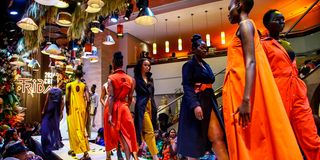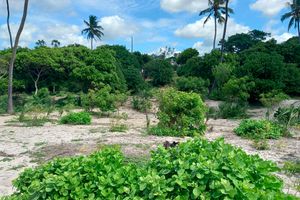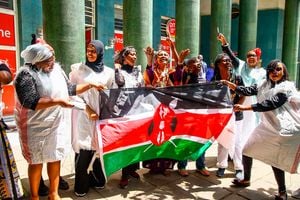
Models at showcase Neutral African prints at the Tribal Chic Fashion Show 2024.
A few weeks ago, I learned something that completely shifted my perspective on the future of fashion. A friend from the industry shared that polyester, once dismissed as the “dark horse” of textiles, is now being embraced by high-tier brands as part of innovative blends shaping a non-cotton future.
This revelation was both surprising and thought-provoking, especially as we recently celebrated World Zero Waste Day under the theme of “Towards Zero Waste in Fashion and Textiles.”
This couldn’t be more timely, given the devastating environmental impact of the textile industry that produces over 100 billion new garments each year globally (a figure that is expected to rise to 200 billion by 2030) and of which 92 million tonnes end up in landfills!
According to a 2023 UNEP report the sector contributes between 2 and 8 per cent of global greenhouse gas emissions, consumes enough freshwater to fill 86 million Olympic-sized swimming pools annually, and is responsible for 9 per cent of microplastic pollution in our oceans.
These figures are consequences visible in our own communities. In Kenya, the Dandora dumpsite stands as a stark testament to this crisis, with towering piles of discarded clothing accumulating daily. Keeping in mind that 60 per cent of modern textiles are made from synthetic, plastic-based materials such as polyester, acrylic, and nylon.
When these fabrics are improperly disposed of or incinerated, they release harmful pollutants, leading to environmental degradation and posing serious health risks to nearby residents and waste pickers.
While the fashion and textile industry provides employment to nearly 12 per cent of the global workforce and fulfils a basic human need for clothing and self-expression, its prevailing linear business model of “take-make-dispose” is unsustainable.
In recent years, the rise of fast fashion has transformed the industry, with brands prioritising quantity over quality. The ease of online shopping and the influence of social media have fuelled a culture of overconsumption, leading producers to use cheap, plastic-based materials and, in some cases, exploitative labour practices.
Developed countries, after short usage cycles, frequently export these discarded clothes to African nations, including Kenya, in a practice some term “waste colonialism.”
Ironically, Kenya ranks among the top apparel exporters in Sub-Saharan Africa, bolstered by strong government support for the textile industry yet we are also Africa’s biggest importer of second hand clothing, importing clothes and textiles worth Sh38.5 billion in 2023, surpassing Nigeria.
The popularity of “mitumba” (second-hand clothes) in our culture provides affordable clothing options and supports livelihoods including providing jobs to over three million Kenyans. However, it also underscores the decline of our domestic textile industry, which once produced durable, high-quality garments.
Moreover, a significant portion of imported second-hand clothing (about 200,000 tonnes annually) is of such poor quality (aptly known as “fagia”) that it is unsellable and ends up in landfills, the Nairobi River or worse, burned as fuel for street food like peanuts creating toxic smoke.
But one need not look far to find shining examples of African-led stories that strike a balance between the economic benefits of this industry and mitigating its environmental harms.
A few years ago, at the sidelines of the New York Climate Summit, I met Philip Osafo-Kwaako, Executive Director of Akosombo Industrial Company Ltd. He expressed frustration at the reality that while West Africa produces cotton, there is limited value-addition occurring and the cotton-apparel value chain.
At the same time, there is increasing global demand for sustainably produced apparel – an opportunity to kick-start a vertically integrated cotton value chain utilizing local organic cotton, and sustainable methods (renewable energy, decarbonised processes, recycled fibres) to create premium, circular products from West Africa.
Philip’s Akosombo Textiles, located in Ghana’s Eastern Region, exemplifies Africa’s potential to localise manufacturing within a sustainable cotton value chain.
This ambitious project addresses a critical challenge: despite West Africa producing 10 per cent of global cotton exports, the region lacks significant value addition and suffers from an underdeveloped cotton-apparel ecosystem.
Akosombo Textiles aims to leverage this untapped opportunity by utilising local organic cotton and renewable energy sources, such as hydroelectric power and biomass steam boilers, to produce circular and premium textiles. The project promises both environmental and economic benefits, including the creation of 10,000 direct manufacturing jobs and 50,000 indirect jobs.
Reimagining textiles is not a luxury – West Africa’s green competitive advantage is clear. The likes of Akosombo textiles should be thriving as they leverage local manufacturing that is good for people, nature and climate. By embracing sustainability, investing in circular systems, and honouring the dignity of those who make and wear our clothes, we can move towards a truly zero-waste fashion future.
Wanjira Mathai is the MD for Africa & Global Partnerships at the World Resources Institute and Chair of the Wangari Maathai Foundation.













